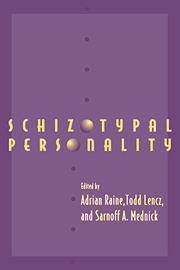Crossref Citations
This Book has been
cited by the following publications. This list is generated based on data provided by Crossref.
Walker, Elaine F.
Neumann, Craig C.
Baum, Kym
Davis, Dana M.
Diforio, Donald
and
Bergman, Andrea
1996.
The developmental pathways to schizophrenia: Potential moderating effects of stress.
Development and Psychopathology,
Vol. 8,
Issue. 4,
p.
647.
Park, Sohee
and
McTigue, Kristin
1997.
Working memory and the syndromes of schizotypal personality.
Schizophrenia Research,
Vol. 26,
Issue. 2-3,
p.
213.
Kremen, W.S
Faraone, S.V
Toomey, R
Seidman, L.J
and
Tsuang, M.T
1998.
Sex differences in self-reported schizotypal traits in relatives of schizophrenic probands1Portions of this article were presented at the 6th annual meeting of the International Congress on Schizophrenia Research, Colorado Springs, CO, 12–16 April 1997.1.
Schizophrenia Research,
Vol. 34,
Issue. 1-2,
p.
27.
Moritz, Steffen
Andresen, Burghard
Naber, Dieter
Krausz, Michael
and
Probsthein, Ellen
1999.
Neuropsychological Correlates of Schizotypal Disorganisation.
Cognitive Neuropsychiatry,
Vol. 4,
Issue. 4,
p.
343.
Dickey, Chandlee C
McCarley, Robert W
Voglmaier, Martina M
Niznikiewicz, Margaret A
Seidman, Larry J
Hirayasu, Yoshio
Fischer, Iris
Teh, Eng Kaet
Van Rhoads, Richard
Jakab, Marianna
Kikinis, Ron
Jolesz, Ferenc A
and
Shenton, Martha E
1999.
Schizotypal personality disorder and MRI abnormalities of temporal lobe gray matter.
Biological Psychiatry,
Vol. 45,
Issue. 11,
p.
1393.
Walker, Elaine F
Logan, Colleen Byrne
and
Walder, Deborah
1999.
Indicators of Neurodevelopmental Abnormality in Schizotypal Personality Disorder.
Psychiatric Annals,
Vol. 29,
Issue. 3,
p.
132.
Lee, Kwang-Hyuk
and
Williams, Leanne M.
2000.
Eye movement dysfunction as a biological marker of risk for schizophrenia.
Australian and New Zealand Journal of Psychiatry,
Vol. 34,
Issue. (Suppl.),
p.
S91.
Irwin, Harvey J.
2001.
The relationship between dissociative tendencies and schizotypy: An artifact of childhood trauma?.
Journal of Clinical Psychology,
Vol. 57,
Issue. 3,
p.
331.
Meehl, Paul E.
2001.
Primary and secondary hypohedonia..
Journal of Abnormal Psychology,
Vol. 110,
Issue. 1,
p.
188.
Lynam, Donald R.
and
Widiger, Thomas A.
2001.
Using the five-factor model to represent the DSM-IV personality disorders: An expert consensus approach..
Journal of Abnormal Psychology,
Vol. 110,
Issue. 3,
p.
401.
Arseneault, Louise
Moffitt, Terrie E.
Caspi, Avshalom
and
Taylor, Alan
2002.
The targets of violence committed by young offenders with alcohol dependence, marijuana dependence and schizophrenia‐spectrum disorders: findings from a birth cohort.
Criminal Behaviour and Mental Health,
Vol. 12,
Issue. 2,
p.
155.
Moritz, Steffen
and
Andresen, Burghard
2002.
Analyse der Schizophreniespezifität schizotypischer Fragebogenskalen.
Zeitschrift für Psychologie / Journal of Psychology,
Vol. 210,
Issue. 3,
p.
141.
O'Flynn, K.
Gruzelier, J.
Bergman, A.
and
Siever, L.J.
2003.
Schizophrenia.
p.
80.
Besteiro-González, J.L.
Lemos-Giráldez, S.
and
Muñiz, J.
2004.
Neuropsychological, Psychophysiological, and Personality Assessment of DSM-IV Clusters of Personality Disorders.
European Journal of Psychological Assessment,
Vol. 20,
Issue. 2,
p.
99.
Walker, Elaine
Kestler, Lisa
Bollini, Annie
and
Hochman, Karen M.
2004.
Schizophrenia: Etiology and Course.
Annual Review of Psychology,
Vol. 55,
Issue. 1,
p.
401.
Raine, Adrian
2006.
Schizotypal Personality: Neurodevelopmental and Psychosocial Trajectories.
Annual Review of Clinical Psychology,
Vol. 2,
Issue. 1,
p.
291.
Meloy, J. Reid
and
Reavis, James A.
2007.
Severe Personality Disorders.
p.
181.
Byrom, Greg N.
2009.
Differential Relationships between Experiential and Interpretive Dimensions of Mysticism and Schizotypal Magical Ideation in a University Sample.
Archive for the Psychology of Religion,
Vol. 31,
Issue. 2,
p.
127.
2010.
Psychosis and Spirituality.
p.
253.
Thakkar, Katharine N.
Nichols, Heathman S.
McIntosh, Lindsey G.
Park, Sohee
and
Herzog, Michael H.
2011.
Disturbances in Body Ownership in Schizophrenia: Evidence from the Rubber Hand Illusion and Case Study of a Spontaneous Out-of-Body Experience.
PLoS ONE,
Vol. 6,
Issue. 10,
p.
e27089.





